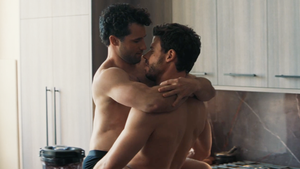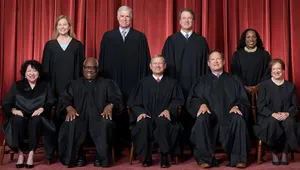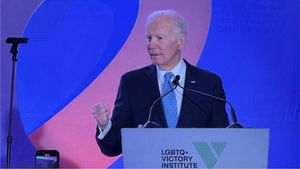CONTACTCAREER OPPORTUNITIESADVERTISE WITH USPRIVACY POLICYPRIVACY PREFERENCESTERMS OF USELEGAL NOTICE
© 2025 Pride Publishing Inc.
All Rights reserved
All Rights reserved
By continuing to use our site, you agree to our Privacy Policy and Terms of Use.
My father, Angel Alumit, loved the Philippines. Any pride I have about the country of my birth comes from him. He once said to me, "As long as a drop of your blood originated from one of those 7,000 islands, you, your children, and all the children after will always be Filipino." When I told my dad that I'd be visiting the Philippines, he said, "Oh, yeah?!" He was more excited than I was. Excitement was not something he felt easily, especially when he came out of dialysis. His diabetes had affected his feet, leaving them swollen and sore. It became unbearable for him to walk. Most times he was too weak to converse. So I'd sit with him and he'd fall asleep. Soon after his admission to the hospital, my mother called me and said she had summoned a priest to give my father last rites. Diabetes claimed him in March. My trip to the Philippines was scheduled for October.
"Maybe I shouldn't go," I said.
"Of course you should go," my mom said. "It's more important now that your dad is gone. Our relatives will want to see the son of Angel Alumit." I had visited the Philippines briefly only once before, during my college years in the '80s. I, like other guys barely in their 20s, spent most of my time clubbing and getting drunk. I was consuming the local San Miguel beer rather than drinking in the country that my father loved.
Now I knew I could look at the Philippines differently, especially one part of the country that I'd heard so much about: the Banaue Rice Terraces in the northern province of Ifugao. The Rice Terraces are almost legendary, older than the Christian calendar and a mark of pride among Filipinos for showcasing their ancestors' ingenuity in carving small fields of rice in what look like great steps up the sides of mountains. The Rice Terraces, located in the mountain provinces of central Luzon Island, are not easily accessible. Fortunately my travels would be taking me to the area, also home to my extended family.
I exited the comfortable, nicely air-conditioned cabin of Malaysia Airlines, arriving to the tropical heat of Manila, enjoying the rain that fell during my first hour there. It wasn't the cold, harsh rain that I'd experienced in America. It was warm, the kind of water most desired while bathing. It was October, nearing the tail end of the rainy season (November through March being the prime months to best enjoy the islands).
I chose to stay in the Malate area of Manila because of its proximity to Manila Bay and its reputation as a gay hot spot. I immediately headed to Baywalk on Roxas Boulevard, a stretch of land along the Manila Bay. Forty years ago, my father walked with my mother along this bay before embarking on a new life in the United States. It's known as a place to take long, lively strolls, perfect for warm tropical evenings. Colored lamplights shaped like big cotton balls illuminated the walk, complemented by sparkling flames of candles and lanterns strung along the way.
(There's a long-held rumor that there is a "Miss Saigon" school somewhere in the country continuously training young girls to play the title role in future productions.)
I walked to Orosa Street near Nakpil, the gay epicenter. Gay men and lesbians sit in the courtyard of the open-air New York Caf? or shop at the gay bookstore Pride Exchange. I made my way through the courtyard to Bed, a stunning gay bar bathed in red light, with walls made of red vinyl. Two handsome bouncers in red T-shirts stopped me and requested my ID. They wore hard hats in keeping with the night's theme: construction.
One bouncer looked at my California driver's license and said, "Oh, you're American. I thought you were Filipino."
"I'm both," I said.
There was a glow inside Bed; I now know what it would feel like to be embedded in a ruby--a ruby with dance music and plucked-brow men. I went across the street to Bath, another two-story gay bar (that recently closed), with walls covered in tile and lined with showerheads. Well-dressed men hung around outside talking on cell phones. Most Filipino men who identify as "gay" are just as out and proud as those of us in the West. The word gay seemed to be preferred to the word bakla, a term usually associated with transgenders. Up until recently, there wasn't a word for lesbian. An American euphemism was adopted: tomboy, or tibo for short.
On my trip I met tomboys who informed me that the only lesbian bar in Manila closed in the '90s; however, they frequent the same bars that gay men do. The tomboys I spoke to said they travel the country, though they didn't name specific gay travel spots.
"Wherever we go becomes a gay travel spot," one woman told me.
I visited other areas of the gay Philippines where that sentiment seemed to be true. I checked out areas made famous in movies like Macho Dancer and Midnight Dancers, films that found art-house success in America. Those movies showcased male strippers in bars like Uniasia Club on Mabini Street in Malate, and Gigolo and Adonis, both on Timog Avenue in Quezon City, another area of Manila.
I walked into one macho-dancer bar and a bakla who introduced herself as Mamasan welcomed me and said, "Are you all alone?"
"Yes."
"Let me get you a model to spend time with."
"No, that's OK. I'm not interested in prostitutes."
"Sir!" Mamasan said, disgusted. "We don't do that here!"
She returned, and behind her were 10 of the handsomest men I'd ever laid eyes on. They ranged from 5 foot 3 to six feet. Some were slender, some beefy. Some had spiky hair while others had long hair, slicked back. My jaw dropped.
"No, really, I don't want--"
"This is Rommel."
I had no intention of paying for anyone's company. Fully embarrassed, I wanted to leave. At the same time, I felt obligated to stay. I shifted in my seat. I believed that there was something wrong with this. Maybe this wasn't prostitution, but it seemed close to it.
I looked up. Rommel's big brown eyes sparkled when he smiled. He wore his hair extremely short, almost bald. Lovely. I'd have to psyche myself up just to say hello to such a man at a party in Los Angeles.
Rommel said, "Good evening."
I looked up and sighed, "I'll take Rommel."
The other models cheered and slapped Rommel on the back like he'd won a bet. I wish I could say that Rommel and I had a wonderful, passionate time. "Good evening" seemed to be one of the few English phrases he knew.
"I student," he said, then picked up a menu and ordered several dishes and drinks.
"So, what province are you from?" I asked.
"Better if you speak Filipino, Tagalog maybe."
"My Tagalog is not that great."
"Huh? I'm no good speaking English."
I paid the bill, which along with Rommel's time and food came to about $50. I left frustrated, wishing my language skills were better. My parents decided to teach me only English so that I could operate better in our new home in the States. Isn't that what America is for the immigrant? A place to begin forgetting. And what happens to the immigrant's son? He returns to his father's land to fix the amnesia.
In the morning, I spent a day at Intramuros, the walled city in Manila. Intramuros was a symbol of Spanish pride, a stone fortress complete with moat and drawbridge, a center of commerce and culture. It was devastated during World War II and only a hint of its grandeur remains, though commerce and culture are still present. A calesa (horse-drawn buggy) ride through Intramuros revealed examples of Spain's 400-year occupation of these islands. The most significant and lasting effect of that time is the prevalence of Catholicism. The churches erected in Intramuros--Manila Cathedral and Saint Augustine's--are awesome spectacles of Spain's reverence for the church. (Catholicism is still a strong force in the Philippines, but the stinging dogma against homosexuality isn't as dominant there as it is in Western countries.) St. Augustine's Church is now a museum showcasing the wealth of the Spanish crown, with ornate furniture and intricately designed frocks.
The United States won the Spanish-American War in 1898 and claimed the archipelago for itself, much to the dismay of Filipinos who had broken free of the Spaniards only to discover they had to answer to a new master. The United States finally gave the Philippines independence shortly after WW II.
English is one of America's most lasting contributions to the islands, with many Filipinos fluent in the language. This widespread English fluency makes the Philippines a hotbed for outsourcing. Having problems with your computer? Call the toll-free number. Chances are you're calling the Philippines to solve problems about connecting to the Internet.
English proficiency helps keep the Philippine economy afloat. Nurses, doctors, engineers, nannies, maids, truck drivers, and teachers from the Philippines find work in America, Great Britain, Australia, Canada, and other places where English is spoken. The money the overseas workers send home helps keep the country from collapsing. America is a dream for lots of people around the globe, and Filipinos are no exception: The Philippines has the longest waiting list in the world of people trying to get to the States. For some the wait could be as long as 25 years.
In addition to English, mall culture has influenced the Philippines in a big way--perhaps a sign of economic prosperity in a country that so needs it. Louis Vuitton and Ralph Lauren are familiar names that a traveler will encounter here, along with Starbucks and McDonald's. With the exchange rate being what it is--about 55 pesos to the dollar--one can buy authentic name brands for a mere pittance. But I instead bought a variety of barongs, light, airy shirts that so signify the Philippines. Visiting dignitaries, from Prince Charles to Bill Clinton, wear the barong as a sign of cultural respect. I had only a few in Los Angeles, one of which was given to me by my father. When he died, my mother offered me his old barongs.
In Manila I wore light, breathable fabric and drank lots of water to stay hydrated in the tropical heat. I longed for the cool climate of the mountain provinces, where my family is from. When one thinks of the Philippines, one generally thinks of beaches. The Philippines features some remarkable beaches, like the white sands of Cebu and Borocay (which a friend, perhaps over-enthusiastically, described as the Fire Island of the Philippines) and the shores of Palawan Island.
Baguio is a place of escape. Droves of people leave the lowlands, especially in summer, to feel the cool, refreshing air of this mountain city. With six universities in the area, there is a youthful energy about the place. Burnham Park, in the heart of the city, has a bike park and a small lake with boats shaped like swans and dragons. Minesview Park offers rides on ponies with manes dyed pink. Punk ponies! Only in Baguio.
The gay scene in Baguio is small compared to Manila. Gay bars in the area are located on Naguilian Road, just outside of Baguio. At the height of its gay scene in 2002 there were four gay bars in Baguio, but only one remains: Malebox, a macho-dancer bar.
I met relatives who were anxious to see me. I was told that when my father died a vigil was held in his name for an entire week. They saw the videotape of my father's funeral, the one my mother sent. They didn't know I chose the casket or that I selected the music or or that I wrote the most difficult thing in my life: my father's eulogy. They didn't know that I had to dig real deep to find the strength to plan a parent's funeral, strength I didn't know I had. I had spent 36 years getting to know him, working out the kinks, and only weeks before his death we could sit in the same room quietly, feeling like we finally fit.
"You look just like your dad," an aunt said. "Just like him."
Looking at the faces of my relatives I believed we all looked
like my dad. Frankly, a lot of people in Baguio look related. It wasn't until
the early 1900s that a road connected Baguio to the rest of the Philippines,
and thus to the rest of the world. It
hadn't been a hundred years since the Igorots, the natives of the mountains,
had begun to mesh with other Filipinos. In America there is so much wonderful
diversity. I forgot that there are entire races of people who can look so similar.
"Why aren't you married?" my aunt asked.
Some cousins and an uncle who knew my sexual orientation looked to the floor. I smiled. On this somber occasion, in a room full of grieving relatives, I chose not to discuss my sexuality. I said, "I'm not married because I like being free."
By moving to America my parents guaranteed my freedom, particularly as a gay man. If my parents stayed, I probably would have gotten married and had children, sneaking out to the gay bar outside of Baguio. My father gave up his freedom so that I can have mine. He left the Philippines for his children. He left a comfortable life, all of his friends and family, to live in Filipinotown in Los Angeles and become a security guard. Growing up, I knew he kept looking over his shoulder to see if the Philippines was still there. Maybe that's why he was so critical about my life: He didn't want me to take wrong turns like he felt he did.
Later, my cousins showed me around town, a place that had changed since my last visit. It had become more metropolitan, with a huge mall atop Session Road, the city's main thoroughfare. I bought fabric from the Easter Weaving Room, a fine place to see weavers work on large wooden machines the size of VW Beetles.
"What do you want to do while you're here?" my uncle asked.
"I'd like to see the Banaue Rice Terraces."
"Ah."
We left at 5 a.m., hoping to arrive in the early afternoon. The road was mostly smooth, with a few bumps. More than one rooster crossed our path, slowing the drive time. To each side of the road, the periphery was golden with newly harvested rice set out in the sun to dry.
I arrived to the magnificent sight of those terraces, a valley of carved crops along mountains, one layer after another, a tribute to a people's staple of existence: rice. They rose from the ground, climbing into the sky. I marveled at this man-made wonder, thousands of years old, developed with the most rudimentary of tools. Shelves of sustenance angling their way into the clouds. I thought of my dad and chose to see these terraces by their other name: The Stairway to Heaven.
Alumit is the author of the novel Letters to Montgomery Clift.
ESSENTIALS: MANILLA
Accommodations
Inexpensive: (Add 011-63 before
all phone numbers) For Old World charm, we suggest Garden
Plaza Hotel and Suites (1030 Belen St., near General Luna Street,
in Paco, Manila; 2-522-4835; $30-$80). Garden Plaza has a friendly, helpful
staff and a pretty hanging garden on the second floor. Moderate: Hotel
Frendy (1548 A. Mabini St., near Pedro Gil Street; 2-526-4211;
$35--$100) in the trendy Ermita district of Manila is a newer hotel, close to
the gay district of Malate. Expensive: If you're into finer living, the
Makati area of Manila will suit you just fine, with five-star showcases like
the Shangri-la Hotel (corner of Ayala and Makati avenues; 2-813-8888;
$160-$400).
Restaurants
The
Aristocrat (Roxas Boulevard and San Andres Street in Quezon
Memorial Circle, near Baywalk; 2-524-7671) offered the most tender lechon
(roasted pork) we have ever tasted. Right across the street is Max's
Fried Chicken (998 Roxas Blvd. at Remedios Street, Malate; 2-404-3556),
a restaurant whose signature dish is legendary.
Attractions
A must-see is Intramuros, the walled city
of Manila, located at Bonifacio Drive and Padre Burgos Street. You can easily
spend the whole day there visiting museums and churches and eating. Then hang
out at night for the block party, which starts around 9 p.m. Also check out
the pristine grounds of the Ayala Museum (Makati Avenue at De La Rosa
Street, Greenbelt Park, Ayala Center; 2-757-7117), where you'll find dioramas
on the country's history, ethnic art, and even miniatures boats.
Nightlife
The gay scene is located at Orosa and Nakpil
streets in the Malate area of Manila. Bed
(2-536-3045), a two-story bar located in Orosa Courtyard, is charmingly red
with the cutest doormen.
ESSENTIALS: BAGUIO CITY
Accommodations
Inexpensive: Stay at Tam-awan
Village (Pinsao Proper; 74-446-2949; $5-$12) and see how locals used to
live a hundred years ago in this replica of a native village. Moderate: Burnham Hotel (20 Calderon St.; 74-442-2331; $20-$50) is beautifully
decorated with local wood tchotchkes. Expensive: Hotel Veniz (One Abanao
St.; 63-74-446-0700; $75-$100) is a new hotel with all the modern amenities.
Attractions
Hang out at Burnham Park (Harrison Road
and Abad Santos Street) and take a ride in one of their swan-shaped canoes.
Sunflower Festival
The remote town of Pasuquin on Luzon island is the setting for the Sunflower Festival, an offshoot of the Catholic Santacruzan holiday. Each May the entire town turns out to watch an elaborate "royal" procession of famous queens--including Makeda, queen of Sheba, and Nefertiti of Egypt--culminating with the climactic entry of the Reyna Helena, the festival queen. No one in this ultratraditional town seems to mind that they're all cross-dressing pa-girls. In Shawn Hainsworth's 1997 documentary, Sunflowers, a priest suggests that the drag shows encourage more people to come to the festival, thereby helping gay men atone for their sinful acts and be better accepted by the townspeople in this farming community. This year's festival had to be canceled: The designated Reyna Helena backed out, and organizers couldn't find a last-minute pa-girl replacement. The information in this story was accurate at the time of publication. We suggest that you confirm all details directly with the establishments mentioned before making travel plans. Please feel free to e-mail us at update@outtraveler.com if you have any new information.From our Sponsors
Most Popular
Just in Time for Pride – The 15 Gayest Cities in the World in 2023
April 12 2023 6:47 PM
The 13 Least Visited National Parks
January 07 2023 5:00 AM
Get Soaked! with These 35+ Steamy Pool Pics From This Year’s White Party
May 25 2023 9:29 AM
20 Thirsty Pics of #SniffiesRush Campaign Celebrating Frat Life
December 16 2022 3:19 PM
25 Thirsty Pool Party Pics from White Party Palm Springs 2022
April 14 2023 5:55 PM
Sniffies Reveals Horniest Cities
December 22 2022 4:15 PM
15 Thirsty Pics of Moot Lingerie for Men
March 21 2023 7:41 AM
The 7 Best Nude Beaches for Gays in the U.S.
June 09 2022 4:00 AM
The Most Dangerous (& Safest) Countries for LGBTQ+ Travel
March 22 2023 5:00 AM
Outtraveler: Featured Video
Latest Stories
A gay solo traveler goes bear-hunting in Barcelona
November 13 2025 4:31 PM
More than a month: Prioritizing LGBTQ+ health year-round
October 15 2025 12:27 PM
UNITY at Sphere is the perfect Las Vegas attraction for gay tourists
October 03 2025 5:09 PM
Malta is the secret Pride destination where gays are going wild
September 18 2025 4:47 PM
What is a Jubilee? These Catholics just became the first LGBTQ+ people to participate
September 08 2025 12:49 PM
Marriage equality will be banned in these 31 states if Obergefell is overturned
September 08 2025 10:40 AM
Explore the camp, parties, and parade of Provincetown Carnival 2025
September 05 2025 7:03 PM
My big gay Broadway summer
August 27 2025 9:27 AM
Explore Zurich with Swiss style icon Susanne Bartsch
August 25 2025 9:46 AM
Splash House is the secret Pride festival where gays can truly let loose
August 22 2025 9:00 AM
When love sinks, set sail for the Hudson Navigator
August 15 2025 6:00 AM
Need an escape from American anxiety? Consider Colombia.
July 16 2025 11:47 AM
This heavenly hotel in the heart of Hell's Kitchen is the perfect oasis
June 26 2025 6:00 AM
Top 10 LGBTQ+ beach towns perfect for Pride and summer fun
June 05 2025 1:54 PM
Checking out: nhow London, the city’s coolest hotel
June 02 2025 8:45 AM
Cruising the world helped this gay couple find lasting love
May 31 2025 2:45 PM
Gays went feral at an iconic Pride celebration in Pensacola, Florida
May 30 2025 6:00 AM
Wilderness, woods, and Wigstock: Drag icons light up the Catskills
May 28 2025 12:17 PM
Out and About with Christian Cooper
May 28 2025 11:07 AM












































































